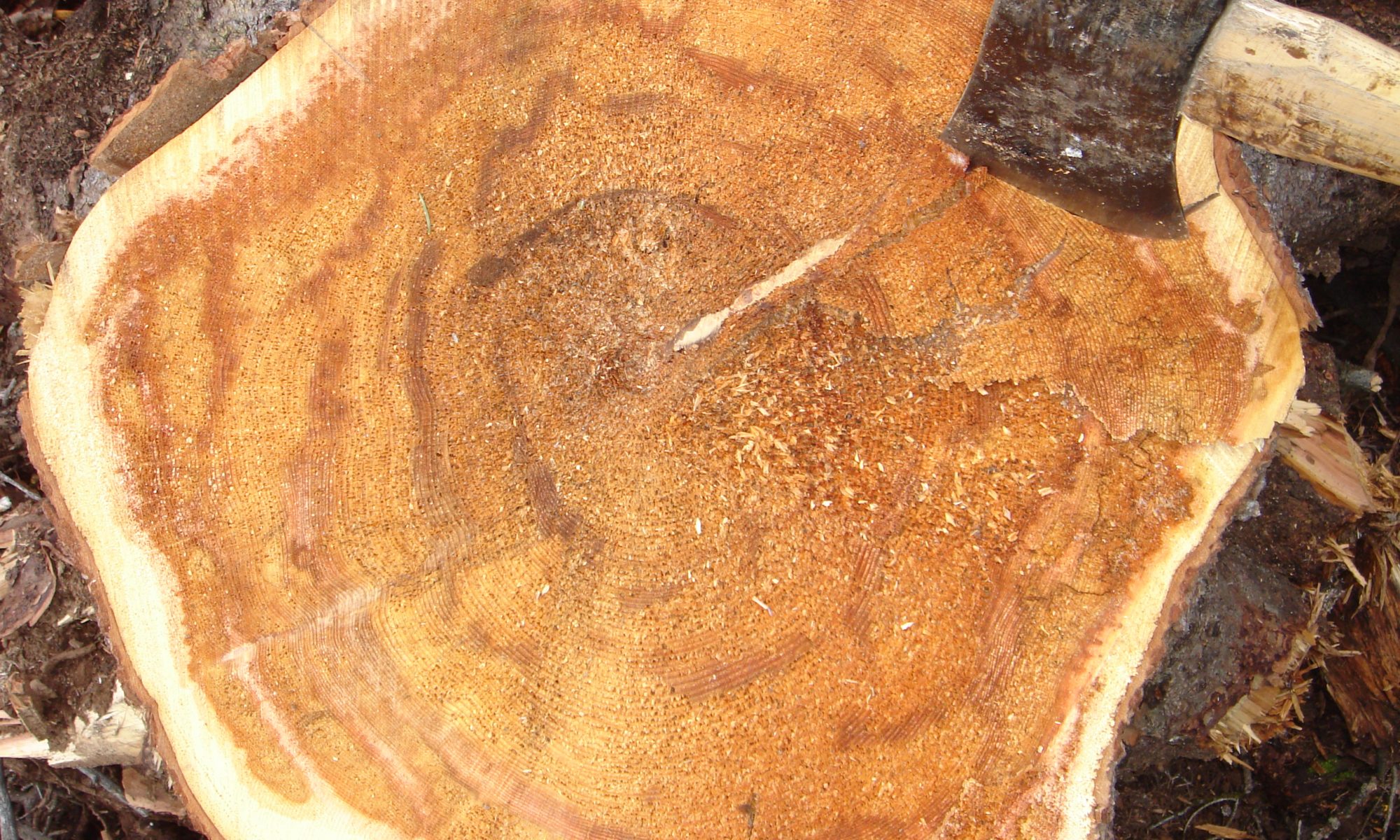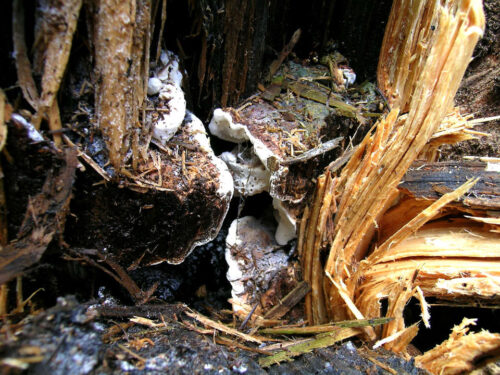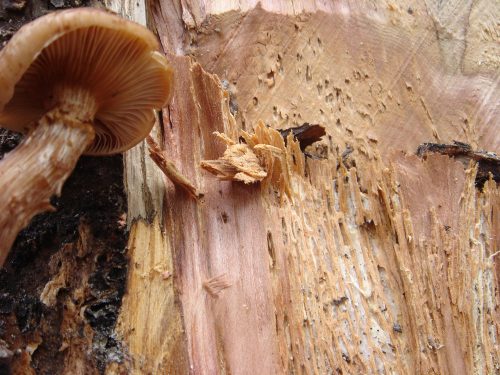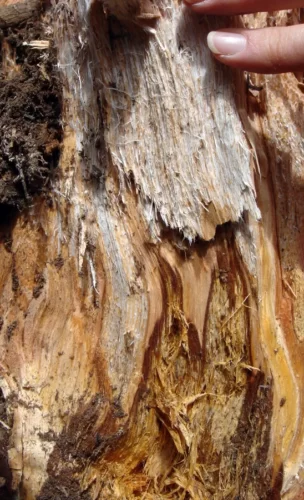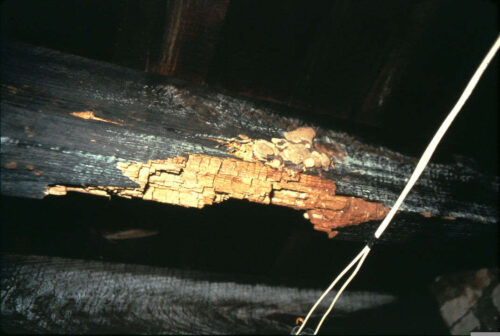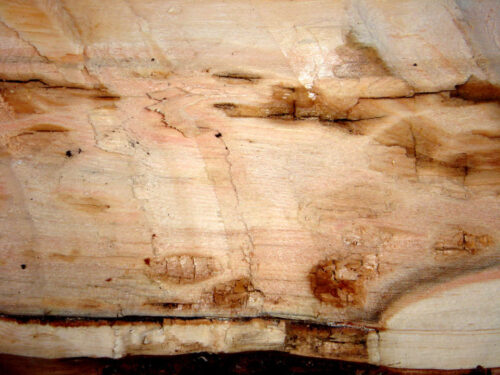- What is wood decay?
- Wood decay (= wood rot) is decomposition of structural components of wood by microorganisms, primarily by enzymatic activity.
- What causes decay in wood?
- For practical purposes, fungi are the only agents of wood decay. Most wood decay is caused by basidiomycetes, although some ascomycetes can also decay wood. There are other kinds of deterioration, by insects, marine animals, ultraviolet light, etc., but this is not decay, nor is it quantitatively as important as decay.
Wood decay is hugely important economically and ecologically:
The Good | The Bad |
|---|---|
|
|
This page has general information on wood decay. You may be interested in more specific information about diseases involving decay in tree stems and roots.
You can find annotated lists of some decays important in North America here.
Contents of this page :
- Wood anatomy and chemistry
- Types of decay
- Terms for decays in various positions
- Disease cycle of decays
- Tree resistance
- Decay of wood in service; Stain
Wood anatomy and chemistry
In order to learn important things about wood decay, you need to know the basics of wood anatomy and chemistry. Here are two tables that provide a very concise start.
Cell Types in Wood
| Softwood (Conifer) | Hardwood (Angiosperm) | Both | |||
|---|---|---|---|---|---|
| Cell Type | Tracheid | Epithelial Cells | Vessel Elements | Fiber | Parenchyma |
| Function | sap conduction + support | Produce resin | sap conduction | support | storage, defense |
| Shape | long, narrow | short, wide | short, narrow | various | |
| Arrangement | connected with pits | Make up the perimeter of resin canals | connected end to end into long vessels | connected with narrow pits | Oriented radially in rays and, in hardwoods, longitudinally near vessels |
In other words:
- Conifers use tracheids for BOTH water conduction and strength/support. These cells die after formation.
- Hardwoods divide those functions into two cell types: vessel elements for conduction, and fibers for support. These also die after formation.
- All trees also have parenchyma cells. These cells are alive in sapwood and can store food and actively defend around wounds, fungal attack, etc. Most parenchyma cells are bundled in rays.
- Finally, most conifers also have epithelial cells, which make up the walls of resin canals. They actively produce resin as a defense mechanism.
- Parenchyma and epithelial cells die during the transformation of sapwood to heartwood. They also die behind cambium that is killed by wounding, disease, or insect attack.
Wood Chemistry
| Component | Approximate composition by weight | Structure |
|---|---|---|
| Cellulose | 50% | linear chains of glucose (beta-bond) |
| Hemicellulose | 25% | branched chains of various sugars |
| Lignin | 25% | A complex, cross-linked polymer based largely on phenylpropanoid units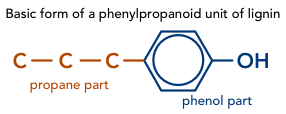 |
Types of wood decay
- What happens to wood when it decays?
- As wood decays, structural components (cellulose, hemicelluloses, and/or lignin) are degraded, its appearance and texture change, and strength is lost. The type of wood decay is generally determined by which components are degraded.
- What are the types of wood decay?
- In general, wood decay has three types: white rot, brown rot, and soft rot.
| Type | Agents | Color | Texture | Chemistry |
|---|---|---|---|---|
| White Rot | Basidiomycota, some Ascomycota | ±bleached | fibrous | all components removed |
| Brown Rot | Basidiomycota | ± brown | fibrous texture lost early, cross-checking | primarily carbohydrates lost, lignin mostly remains |
| Soft Rot | Ascomycota | bleached or brown | usually on surface, some fibrous texture lost, cross-checking in some cases | carbohydrates preferred, but some lignin lost too |
White rot
In white rot, all wood components are destroyed. In most cases, the components remain in roughly the same proportion throughout decay as in the sound wood. White rot is fibrous because some cellulose remains intact until very late stages of decay. It is typically less fibrous in hardwoods than in softwoods because of the shorter fibers in hardwoods. It usually turns whitish because of bleaching by oxidation and loss of lignin, which is slightly brown. Color and texture vary among white rots caused by different fungi:
- stringy white rot
- spongy white rot
- laminated white rot (separation of annual rings)
- mottled white rot
- white pocket rot
- zone lines sometimes present
In some white rots, there is a phenomenon called selective delignification. All components are removed, but the relative rate varies. Lignin and hemicelluloses are selectively removed in early stages. This leaves enriched cellulose. This is what happens in the white regions of a mottled rot and in the pockets of a white pocket rot. There is a tremendous amount of interest in using these fungi in industry, because many uses of wood involve removing lignin (e.g., biopulping).
Ethnopathology
In Chile, selectively delignified wood of the genus Nothofagus occurs in large amounts. It is mostly associated with decay by Ganoderma species and is called palo podrido. Dr. Robert Blanchette reports that Indians in Chile have (had) a god called Trauco. Trauco lives in the forest and looks like a man but has cloven feet. Trauco represents fertility, perhaps in much the same way as Kokopelli of the Indians of southwestern North America. Unwed women who got pregnant often said that Trauco had visited them and he was responsible for their pregnancy. Trauco eats palo podrido, and there are reports that Indians did as well, perhaps to enhance fertility.
In selectively delignified wood there are often pockets of clear, gelatinous remnants of the wood. Armillaria species in particular often cause these gelatinous pockets. This may become colonized by yeast and may contain alcohol. We don’t know what role this may play in the legend, but one noted forest pathologist who was trying to have kids ate some Armillaria jelly while on a trip and his wife became pregnant soon after!
Incidentally, the delignified wood is quite useful as fodder for ungulates. It can be readily broken down with the aid of microorganisms in their gut. Even in Alaska, I have seen evidence that moose have fed on logs decayed by Ganoderma applanatum!
White rot examples
Brown Rot
Brown rot is brown because carbohydrates are removed, leaving brownish, oxidized lignin. There is no fibrous texture because the cellulose is broken up early. The wood shrinks on drying and cross-checking is seen in later stages. It is often called “cubical” brown rot for that reason.
The initial stage of brown rot is non-enzymatic. The fungus produces some small chemical agent (involving oxalic acid and hydrogen peroxide) that zips around in the cell wall like a little pair of scissors, snipping chains of cellulose and hemicellulose into smaller pieces. This happens throughout the wall in fairly early stages. The carbohydrates become partly soluble, enzymes work on them, releasing sugars, and they are slowly absorbed by the fungus.
There is a handful of brown pocket rots, and they are very cool and special. They only develop in living trees, and often in tree species that have unusually durable wood, with otherwise highly effective antifungal chemicals in the heartwood. One can speculate that the occurrence of brown pocket rots in such tree species is probably related to the chemical protection of the wood, but how is a mystery that is yet to be solved. Are they using the sound wood around the pockets as a chemical waste dump?
Brown rot examples
Soft Rot
Soft rot is not known to occur in living trees. It is important in degradation of wood in service. The best known feature is the curious angular cavities in the secondary wall, but they are not always present.
Terms for position of decays



In general, live trees tend to decay from the inside out and dead trees from the outside in. There are various reasons for this, but it is largely due to the fact that sapwood has a very effective active resistance when the tree is alive but virtually no resistance once the tree is dead.
The terms relating to position of decay in the tree are just approximations; the fungi are not necessarily restricted to these regions.
In addition to the terms illustrated at the right (top rot, stem or trunk rot, butt rot, root rot), two that you run into are heart rot and sap rot. Heart rot is often defined as decay in living trees. Some define it as decay that develops primarily in the heartwood or inner wood of living trees. It is usually used to refer to decays that primarily develop in the stem rather than in the roots and butt. Sap rot may refer to saprobic decays or to those that develop in the sapwood. Usually sapwood decays extensively only in dead trees. But there are some fungi that commonly decay sapwood in living trees, usually causing cankers. Such diseases are known as canker-rots. Also keep in mind that saprobic fungi can and do decay dead wood in living trees.
Here we use the term ‘stem decay‘ for all diseases where the primary symptom is decay of stem wood, largely because ‘heart rot’ is thought by some some to imply that decay is restricted to heartwood, which is frequently not the case.
Another term you see is slash rot, simply referring to decay of dead material, particularly branches and tops that are left behind after logging.
Disease Cycle of Decays
Refer to the life cycle of a polypore, as it is closely related to the disease cycle. Then see the detailed disease cycle presented in the Stem Decays introduction page. The decay cycle for saprotrophic fungi (invading dead wood, trees, and branches) is similar except that infection court is not an issue. Root and butt rots tend to have unique disease cycles in important details, so explore individual diseases to learn that.
Tree resistance

Trees have several mechanisms of resistance against decay fungi. Bark is the first line of defense. No stem-decay fungi are known to infect through intact bark.
Sapwood is capable of active response to invasion. Parenchyma cells in sapwood sense the presence of the fungus and initiate a doomsday response. A terminal metabolism kills them, but results in conditions that are unfavorable for fungi. Chemicals limit the progress of the fungi. Second, in many conifers, resin is piped in to seal off the area. Third, the cambium responds to trauma by producing a fairly effective wall in the xylem at that point that often restricts an invader to the wood laid down before then. The wall may extend for some distance away from the invasion or wound.
Heartwood resistance is very different from sapwood resistance. Heartwood is dead and there is no active resistance. Instead, chemicals are deposited in heartwood as it forms by dying parenchyma. They render it more or less inhospitable to fungi. Species vary greatly in heartwood resistance. Redwood, cedars are very high; aspen, birch are very low. Nevertheless, every tree has at least a few fungi that have learned to live in its heartwood and cause heart rot.
Now, knowing the difference between sapwood resistance and heartwood resistance, you can begin to understand the difference in the pattern of decay in living and dead trees that we saw above.
Decay of wood in service, stains
Products deterioration
Buildings, decks, railroad ties, utility poles, bridges, ladders, horticultural uses, etc.
Losses: no good figures, but it is said that 10% of annual cut goes to replace decayed wood. Doesn’t include cost of replacement, liability, cost of preservative treatment.
Moisture content: dry wood won’t decay (and you can take that to the bank: “dry rot” is a misnomer). If you add water to dry wood, it goes to satisfy need of walls, which absorb water. Up to moisture content of 28% (that’s dry weight basis, so 28 g water per 100 g dry wood), added water goes into wall. Above that, you get free water in the lumens. That point is called fiber saturation point. Decay fungi require free water. So wood must be above FSP to decay. For practical purposes, a value of 20% is used as a cutoff, leaving a margin for error. Thus, processors and users should keep wood below 20% moisture content to avoid decay.
Control – 3 approaches
- Keep wood dry. For practical purposes, and a margin of error, the rule is keep it at below 20% moisture content (dry-wood basis). Good construction practices with this in mind are important in buildings, but many construction people and even architects do things wrong.
- Use durable wood. But it must be heartwood!
- Use preservatives. Ideally they should be pressure-impregnated. Painting/dipping are much less effective. Not all wood species treat well, some won’t accept it.
- Creosote – byproduct of coal -› coke for steel, first good preservative, still used.
- Pentachlorophenol – nasty chemical with even nastier contaminant (dioxin). Still used to some extent but not where human exposure is likely.
- CCA – Chromated copper arsenate. Sounds worse than it is. The chemicals get fixed, or bound to the wood so don’t leach out. Safe to handle. Wood treated with CCA or similar chemicals available at lumber stores to general public. Sometimes not as effective as other preservatives though.
Stain
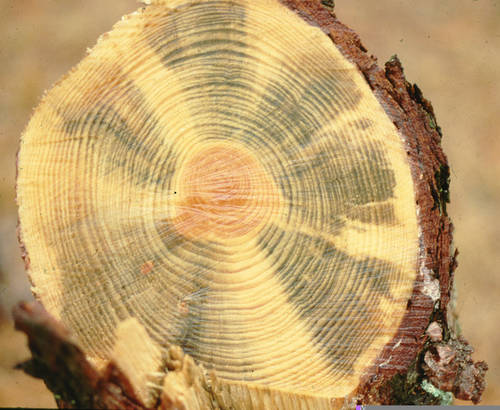

There are many different wood conditions grouped under the term stain, with many different causes. The only one we need to really be concerned with here is blue stain.
This is a blue-grey stain of wood that can tend to being black. It is caused by ascomycetes that have dark brown hyphae. The way light goes through the wood, it ends up looking bluish grey.
The most common and well-known form of blue stain is found in conifers, especially pines, that have been invaded by bark beetles. The beetles carry with them a wealth of microorgansims that are often somewhat specialized to each insect species. Among them are the blue-stain fungi, in genera such as Ophiostoma.
When the beetles attack, they inoculate the tree with their fungus (actually there may be multiple fungi, nematodes, bacteria). The fungus invades the wood, but especially the rays and the resin canals. The rays are heavily colonized. When you look closely at the wood, you can often see dark streaks where the resin canals were stuffed with hyphae. Such wood is common after salvage operations (harvesting recently killed trees), and when logs are stored after cutting under conditions that permit beetle attack.
One hypothesis on the relationship is that the fungus helps the insect by killing cells in the sapwood such as rays and resin canal cells. This reduces the host reaction against the beetle. Another is that the fungi may produce chemicals that are important in beetle maturation. Other things may be involved. In turn, the beetles provides the fungus with vectoring services. This is a symbiosis.
The fungus does not decay the wood, although some strength may eventually be lost. It is used for many purposes such as plywood, rough lumber, etc. It may even be sold as special decorative wood (“blue pine”).
It is not uncommon to find in the literature statements that the fungi help kill the trees by blocking water conduction with their hyphae. Looking at the distribution of the hyphae, you can see that this is impossible. However, their killing of living cells in sapwood may introduce gas bubbles that lead to cavitation and failure of water conduction.
Important Decays
Here are tables of some decays important in North America.

